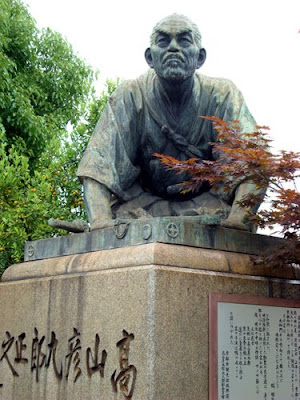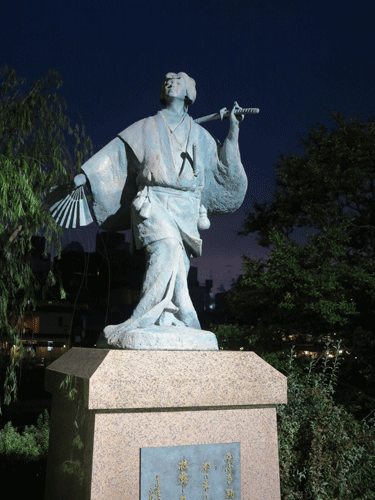Kyoto Statues: Takayama Hikokuro and Izumo Okuni
- Published on : 18/09/2017
- by : Japan Experience
- Youtube
Takayama Hikokuro and Izumo Okuni: Takayama Hikokuro (1747-1793) was a celebrated samurai of the Edo Period (1600-1868). His statue (on Sanjo, a few meters east of Kawabata) is hard to miss.
Takayama Hikokuro and Izumo Okuni 高山彦九郎
Takayama Hikokuro (1747-1793) was a celebrated samurai of the Edo Period (1600-1868). His statue (on Sanjo, a few meters east of Kawabata) is hard to miss.  Statue of Takayama Masayuke on Sanjo Bridge In 1783, on a tour to the capital, he prostrated himself at the eastern end of the Sanjo Bridge, when he saw the ruins of the Imperial Palace in the distance. After a major fire the palace had been left completely unrepaired by the weakening Tokugawa shogunate. In anger, so a popular story goes, Hikokuro beheaded the statues of three Ashikaga shoguns at Tojiin Temple and displayed them in the dry bed of the Kamogawa River in a bold act of protest against the government. His action raised popular support and was part of the anti-Tokugawa movement eventually led to the downfall of the shogunate less than a century later. The imposing bronze statue of him, in the kneeling position, dating from the Meiji Period (1868-1912) is a tribute to his courage and love of Kyoto.
Statue of Takayama Masayuke on Sanjo Bridge In 1783, on a tour to the capital, he prostrated himself at the eastern end of the Sanjo Bridge, when he saw the ruins of the Imperial Palace in the distance. After a major fire the palace had been left completely unrepaired by the weakening Tokugawa shogunate. In anger, so a popular story goes, Hikokuro beheaded the statues of three Ashikaga shoguns at Tojiin Temple and displayed them in the dry bed of the Kamogawa River in a bold act of protest against the government. His action raised popular support and was part of the anti-Tokugawa movement eventually led to the downfall of the shogunate less than a century later. The imposing bronze statue of him, in the kneeling position, dating from the Meiji Period (1868-1912) is a tribute to his courage and love of Kyoto.
Izumo Okuni 出雲の阿国
Facing the huge, storied façade of the Minamiza Theater from across the street, next to the river, half-hidden in a row of large trees, the statue of Izumo Okuni is easy to miss. Her impact on the Japanese cultural scene, however, is not. Izumo singlehandly created the kabuki theater from out of nothing. She is said to have come to Kyoto from Izumo in 1603. Before coming to the capital she was a miko or a young maiden in the service of a Shinto shrine. When she arrived in Kyoto she found a lively street performance scene booming in the city: performers wore colorful clothing and played their instruments closer to the way rock stars do today than anything Japan has seen before.
Inspired and eager to please, she soon acquired a reputation among the lower classes for her wild, often outrageous dance performances on the banks of the Kamogawa River, near the Shijo Bridge, where her statue stands today. He dance was known as the kabuki dance, and before long she had become a celebrated cultural figure throughout the nation. The kabuki theater rose out of her creative madness. Today, the only kabuki theater left in Kyoto stands across from where she first danced so wildly.
By the Same Author
Uji & The Fujiwara Takehei Shoten Bamboo Specialist Sanjusangendo Area Kyoto Tours & Activities






























